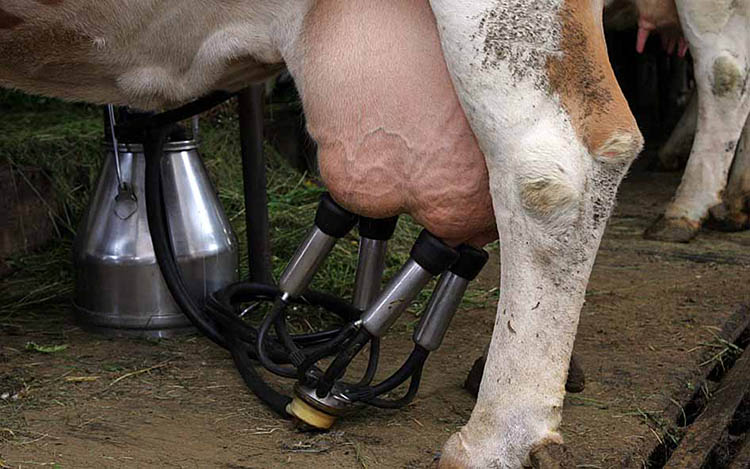Maintenance and use of Milking Machine

The milk and dairy products that we consume today are produced and manufactured by a number of dairy animals among them cow is a significant source of milk. Cows are machine milked today approximately two or three times a day, while the calf uses the suckling method several times a day.
The milking machine works on the calf suckling method basically. In this method, milk is extracted with a help of a rubber liner that is attached on the teat with a light pressure (suction) than the surrounding atmospheric pressure. To prevent the teat from damage, the liner is periodically collapsed to create a massage then relief. This process is referred to as the pulsation and occurs once every second normally.
This working principle was introduced almost hundred years ago and has gone to many modifications. This machine works on regular basis and it is important to take care of its maintenance.
System Design
If you are considering implementing the milking machine on the single farm, you need to consider a plant that suits your requirements to the fullest on that specific farm.
- Consider the number of cows, whether these cows are loose or tied up and to what level these cows are pasture fed.
- You must have knowledge of intended and actual yield levels apart from the calving patterns.
- The level of automation is decided by the labor cost, qualifications and availability.
Plant specifications are also influenced by technical matters, site of farm, electric power, water quality and availability, and access to the road.
- You should also consider the financing and operation costs.
- You should also check for laws and regulations about establishing a farm (if necessary).
- Technical Points That You Should Consider Are:
- Design a vacuum system to handle milk extraction, milk transportation and cleaning.
- Make sure it is capable of transporting milk without too much agitation.
- Make sure it gives strong turbulence in the cleaning water during the process of cleaning.
- Make sure it is capable of operating with a stable level to produce an optimal extraction.
- Make sure it is disturbance tolerant.
- It should be capable of gentle milking, such as it can handle both high and low level of milk without harming teats.
- Get help from a qualified professional in specifying plant. Make sure they have an efficient support system so that you can contact them for help if get any problem.
Deployment
To make the most of your specified plant, make sure you install it correctly. ThatÕs because even a slight installation error could end into big problems, such as it can create operational disturbance or unhygienic conditions. Good installation means the good appearance and facilitating services.
Operation
Milking cows is not an easy job because it requires highly trained workers to ensure the persistent production of milk. Consider following instructions:
- Make sure the easy access of all equipment and tools at the time of milking.
- Wear clean and appropriate clothing.
- Rinse your hands thoroughly before starting milking extraction.
- Handle animals with carefully and gently.
- Clean and massage the udder of cows before starting milking.
- First, premilk in a cup by hand. Check each teat for the blood flocculation.
- Use disinfectant if available.
- Make sure you extract milk at the same time everyday.
- Constantly monitor the milking.
- Extract milk from sick and treated cows separately.
Cleaning
The milk that is extracted from a healthy animal is almost safe to use and sterile. To ensure the high quality of the milk and maintenance, handle it in clean installation. Consider following cleaning instructions.
- Use sufficient and good quality water for better cleaning.
- Make sure that the water heating capacity meets the requirements for cleaning procedure.
- Use detergents carefully.
- Follow the supplierÕs instructions for hand washing.
- Keep the cooling tanks properly cleaned.
- Let the instruments dry completely and make sure water does not collect anywhere.
Cooling
In order to prevent the milk from rapid deterioration after milking, leave it to cooling down at 2-4C within 2 hours. Follow the instructions given below to perform proper cooling:
- Make sure that your cooling tank has the capacity of cooling down the milk within 2 hours.
- Provide gentle agitation to the milk to protect from being deterioration.
- After the collection of milk, clean the milk tank properly.
Maintenance
- Maintenance is important to make sure the constant production of high quality of milk.
- You can take the regular maintenance services from your service supplier.
- A regular maintenance service will reduce production losses and increase constant production.
Consequences
- You can produce a remarkable volume of good quality milk with a correctly specified, deployed, operated and maintained milking plant.
- The quality of milk is measured on the basis of fat and protein. It is valued for human consumption with certain content of nutrients.
- The quality of milk can be measured as total bacteria content that measures the hygienic quality of milk.
- The quality of milk can also be measured as somatic cell content that measures the health of animal or mastitis infections level in the udder.
- The quality of milk can also be measured on the basis of odor (smell) and taste that is the palatability measurement.
- Contamination residues, other impurities, and water quality can deteriorate the water quality.